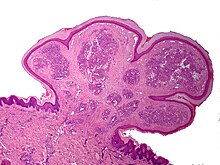Signs and Symptoms
- Appearance ranges from red/pink to purple
- Grows rapidly and can be smooth or mushroom-shaped
- Younger lesions are more likely to be red due to high number of blood vessels
- Older lesions change into a pink color
- Size commonly ranges from a few millimeters to centimeters
- Rapid growth
- Bleeding easily, even with minor trauma
- Red or pink appearance
- Surface ulceration
- Pain or discomfort, especially if located in a sensitive area
Associated Conditions
- Often associated with peripheral giant cell granuloma and peripheral ossifying fibroma
- Association is due to frequent occurrence on gingiva
- Detailed analysis can distinguish these conditions
Cause
- Caused by proliferation of capillaries
- Not caused by infection or cancer
- Trauma
- Hormonal changes
- Poor oral hygiene
- Inflammatory conditions
- Medications
Diagnosis
- Diagnosis can be based on appearance
- Biopsy may be performed for accurate diagnosis and to rule out malignant conditions
- Microscopic examination shows highly vascular granulation tissue and inflammation
- Clinical examination
- Medical history
- Imaging tests
- Differential diagnosis
Management
- Treatment may be considered due to bleeding or ulceration
- Common treatment methods include electrodesiccation and curettage, laser treatment, and topical application of beta-adrenergic antagonist timolol
- No treatment may be needed if the pyogenic granuloma occurs during pregnancy
- Recurrent bleeding may necessitate excision and cauterization
- Minor surgery and dental cleaning may be needed for oral lesions
- Surgical removal
- Cryotherapy
- Electrocautery
- Topical medications
- Prevention measures
A pyogenic granuloma or lobular capillary hemangioma is a vascular tumor that occurs on both mucosa and skin, and appears as an overgrowth of tissue due to irritation, physical trauma, or hormonal factors. It is often found to involve the gums, skin, or nasal septum, and has also been found far from the head, such as in the thigh.
| Pyogenic granuloma | |
|---|---|
| Other names | Eruptive hemangioma, granulation tissue-type hemangioma, granuloma gravidarum, lobular capillary hemangioma, pyogenic fibroma, pregnancy tumor, and tumor of pregnancy |
 | |
| Specialty | Dermatology |
Pyogenic granulomas may be seen at any age, and are more common in females than males. In pregnant women, lesions may occur in the first trimester with an increasing incidence until the seventh month, and are often seen on the gums.